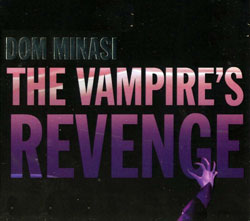
With a huge cast of improvisers, many of whom Minasi had in mind at the writing of the material, Minasi takes on Anne Rice's "Interview with a Vampire." The book is quite large, starting in New Orleans and moving throughout the world, and Minasi's composition is no less large. In fact, it has a huge cast of players: besides Minasi's usual trio of Ken Filiano on bass and Jackson Krall on drums, on various cuts are featured reed men Joe Giardullo, Perry Robinson, Joe McPhee, Blaise Siwula, Ras Moshe, John Gunther, Sabir Matten and Mark Whitecatge, horn players Steve Swell, Paul Smoker and Herb Robertson, on strings Tomas Ulrich and Jason Kao Hwang, bass player Francoise Grillot, pianist Borah Bergman, with Peter Ratray and Carol Mennie on voice and recitation. The pieces employ a variety of configurations - quartets, sextets, up to 13 musicians - in through-composed and sometimes conducted settings.
Minasi cautions not to take this material too seriously, and extolls the listener to smile as they listen. Smile they will, both at the oddly humorous bits ("just one more bite!" screams Carol Mennie) and at the intensely thick improvisations that range from moody dirges to exhilarating explorations. The compositions are often dense but fun to follow, and they do well at conveying the sense of Ann Rice's story through tracks titled "The Seduction," "The Transformation," "Blood Lust" or "The Vampire's Revenge." The playing is often multilayered and interactive, with Minasi keeping the lid on activity that sometimes threatens to boil over. There's a real and appropriate New Orleans feeling in call and response improvisations throughout, and a great deal of drama that doesn't pander to the listener or become anthemic. There is an occassional drift to the motion of some of the pieces, but focus is always returned, and overall it's a very active and dynamic work. Technically the playing is remarkable, sometimes heavy and seemingly impenetrable, but yielding to repeated listening in extremely rewarding ways.
Minasi himself is an impressive and technically monstrous player, from quick odd chord progressions to amazingly rapid runs - Lestat's buddy Armand couldn't have played it better. I suppose that's not surprising for a man who's written two books on jazz theory and chord substitution. Here theory is put into application to the benefit of the music and for those who put the time into a careful listening of this massive work.
Comments and Feedback:



More Recent Reviews, Articles, and Interviews @ The Squid's Ear...


|

